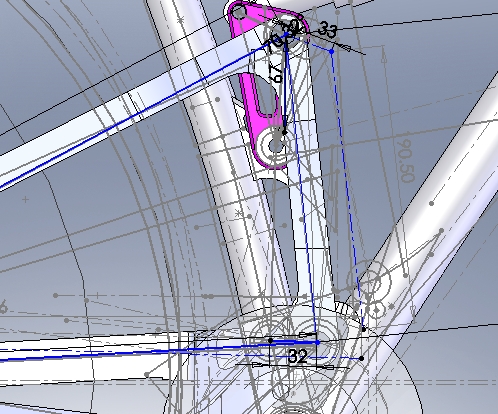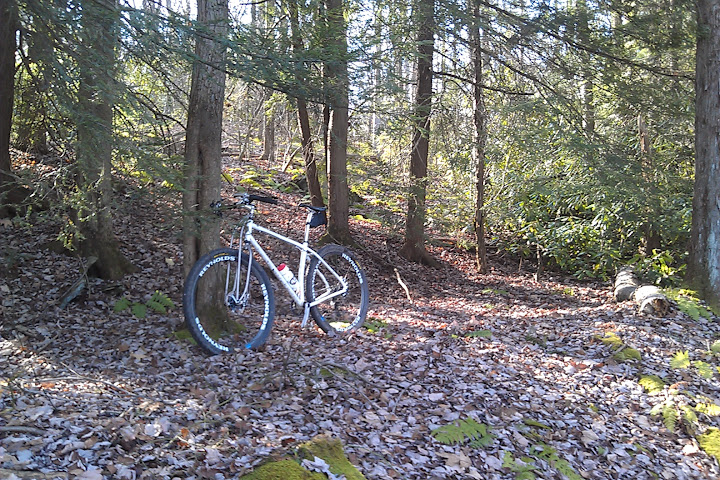After a few days eating turkey and banging my head against my keyboard, I realize I’ve officially entered the “negative obsession” phase of work on my suspension frame, wherein there is nothing even remotely enjoyable about the process and yet I keep working on it pretty much relentlessly. In some ways, the 2007 me who developed the concept for this and put through the patent on the design did 2011 me a huge favor: I have a cozy little intellectual property bubble within which to work away refining things. Nevertheless, I’d very much like to punch 2007 me in the throat for making that bubble really little and apparently out of steel, which makes for a design that’s apparently impossible to finish. All I need now are some acceptable shock rates and a slightly less Dr. Seuss shock position, but that’s seeming hard to come by. Many times, I’ve come really close, only to hit a brick wall and have to redesign everything from the ground up.
So I called a time out today, oranged up to reduce drawing friendly fire, and took the ‘cross bike out for a while–and I’m glad I did, because I actually encountered an exotic species of Mountain Hipster, a smiling guys on lugged steel bikes, one wearing a plaid cap in place of a helmet. They’d just climbed the back road up the mountain and had four miles of poorly graveled road to look forward to before heading down the sketchier Route 30 descent back into town. I’ve seen bear, porcupines, rattlesnakes (too many), foxes, giant-ass-snapping turtles, and turkey vultures up here, but I’ve never seen anyone on a lugged bike with a jaunty cap. Good day.
Halfway down to the spring where I was filling up the water bottle before heading home, I passed Brian, a friend, dedicated racer, and owner of many nice bikes. He had the titanium Indy Fab ‘cross bike out, and we ended up riding back up the mountain together. This was a complicated process for me because:
- I am fat and weak
- Brian is insanely fit–fit way beyond just racing bicycles fit. Fit
- We had plenty to catch up on, which meant talking while climbing
- See #1 above
Before getting back to a batch of tech questions I need to answer for Dirt Rag and the next 1,000 hours I need to spend trying to design a bicycle, I’ll share a tip I have for climbing while having a conversation with someone approximately seventeen times more fit than you are: the key is something I call asymmetric conversing, and it goes like this:
Superfit Racer: “Have you talked to George lately?”
Fat Weakling: “No, no [with feeling].” (Note: minimum syllables and air required to produce those sounds, and the “with feeling” part says, “But have you? Please tell me about it?”)
Superfit Racer: “He’s doing pretty well. I usually talk to him about once a week.”
Fat Weakling: “Wife good?”
Superfit Racer: “Yep, they’re getting situated in their new house. Have you had any bites on the building in Laughlintown? Is it still for sale?”
Fat Weakling: “No, no [again, with feeling].”
Superfit Racer: “So anything you’re working on right now?”
Fat Weakling: “No. Do you believe in God, and why?”
See that? The key is to breath as much as possible by keeping the fit friend talking as much as possible. Think tennis: the more time the ball spends on the other side of the court, the better off you are. It’s simple survival.
And speaking of survival, I’d previously mentioned my idea for a truly tough, Tough Mudder event, but having found out about a guy named Dick Proenneke, I’d like to revise that. Keep your sissy heart rate monitors and tribal tattoos: my newest idea for a competition is to see who can build his or her own cabin in the Alaskan wilderness and live there alone for thirty freaking years. Anything less, and you’re a pampered little bitch.
I call dibs on producing the series, and the celebrity version, so no funny ideas, Mark Burnett.



